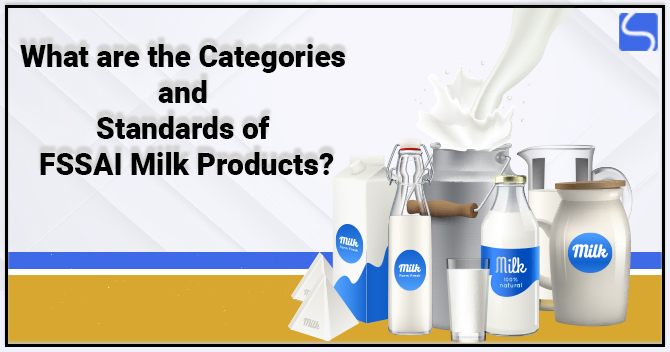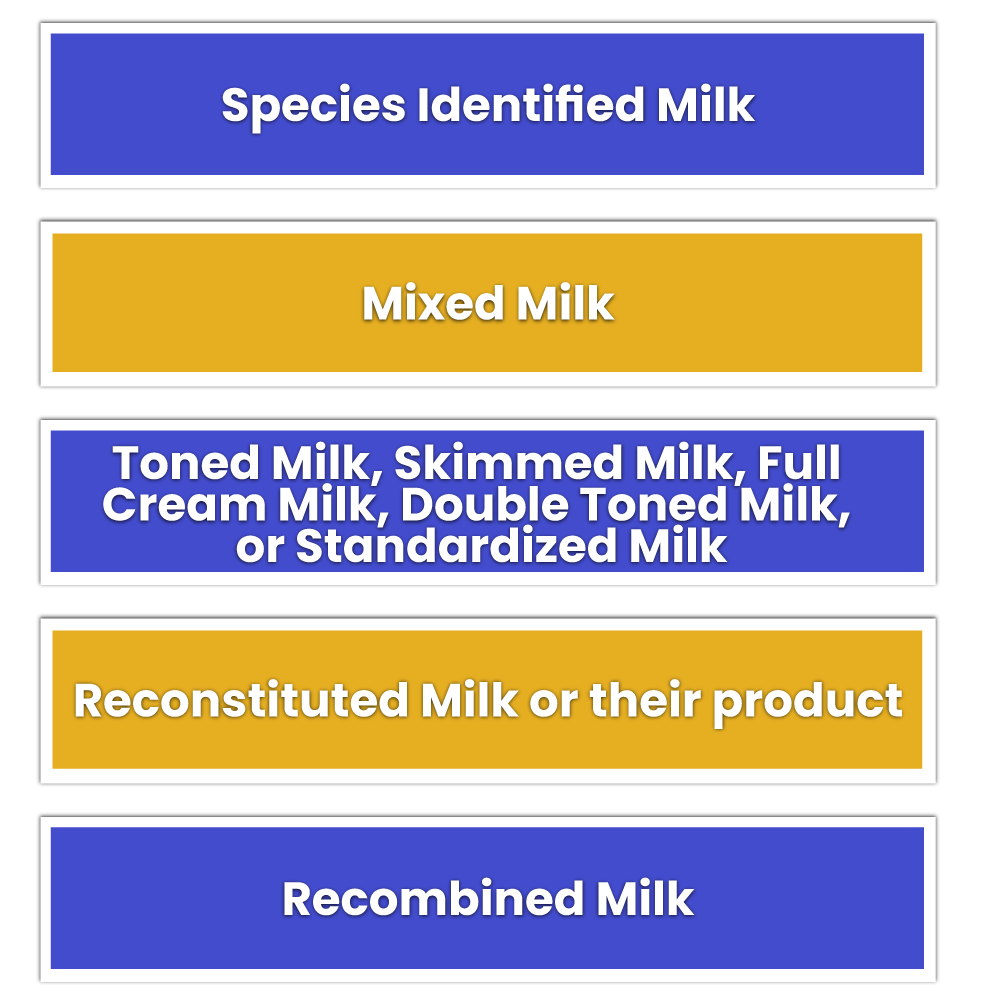What are the Categories and Standards of FSSAI Milk Products?

Karan Singh | Updated: Feb 11, 2021 | Category: FSSAI
In India, where most of the peoples are vegetarian, and they mostly preferred dairy products which are made up of milk. Milk is an important source of nutrition, and it is a great source of protein & calcium. Because of the adulteration of milk products and false claiming of milk products, the food regulating agency has released various categories and standards of FSSAI milk products in the Indian market. Throughout 2017-18, the per capita milk availability in India was 375 gm/day, but now the reports say that it will increase to 592 gm per day. To support all the dairy products in India, the Government has adopted numerous standards, categories and has taken several initiatives. India exports its dairy products to other countries like Singapore, Nepal, Egypt, etc. In this blog, we discuss the categories and standards of FSSAI milk products.
Table of Contents
Different Standards and Categories of FSSAI Milk Products in India
Following are some different categories and standards of FSSAI milk products in India:

- Species Identified Milk: Milk Standards for SNF and fat are different for species of sheep, cow, camel, and buffalo. This milk can be subjected to sterilization, pasteurization, boiling, or Ultra High-Temperature Treatment.
| Species | Milk Fat Percentage (Min.) | Minimum SUF Percentage (%) |
| Cow Milk | 3.2% | 8.3% |
| Camel Milk | 2% | 6% |
| Buffalo Milk | 6% | 9% |
| Sheep Milk and Goat Milk | 3-3.5% (as per difference in-state) | 9% |
- Mixed Milk: This milk is stated to any combination of milk prepared by adding milk of species as we mentioned above and the standard for SNF and fat for combined milk is 4.5% and 8.5%, respectively.
- Toned Milk, Skimmed Milk, Full Cream Milk, Double Toned Milk, or Standardized Milk: All these types of milk also come under the categories of FSSAI milk products, and this milk is made by the combination of buffalo, cow, or any other species of milk as we mentioned above in the table. The standards for it are mentioned below:
| Class of Milk | Milk Fat Percentage (Min.) | Minimum SUF Percentage (%) |
| Toned Milk | 3% | 8.5% |
| Full Cream | 6% | 9% |
| Standardized Milk | 4.5% | 8.5% |
| Skimmed Milk | Not more than 0.5% | 8.7% |
| Double Toned Milk | 1.5% | 9% |
- Reconstituted Milk or their product: Milk resulting from the addition of drinking water to the concentrated or dried form of milk products or mil and it is in the amount required to re-establish the correct the ration of water to solid to make same end milk product.
- Recombined Milk: Milk from the combination of milk SNF and fat are preserved forms with or without the addition of drinkable water to make similar milk product characteristics as per the milk standards.
Previously, the products of milk are very much fragmented, but with the new categories and standards of FSSAI milk products and Government involvement, the customers can make sure that the milk products safety in the Indian market.
Also, Read: Is it Mandatory for Small Businesses to have FSSAI License?
What are the Guidelines for FSSAI Milk Products Packaging?
- FSSAI has announced several guidelines for milk product packaging to make sure that the safety of the milk. The technological advancement has developed new techniques of packaging the FSSAI milk products along with the introduction of new high-tech and good quality machines allowing auto packaging of milk and other dairy products. There are several types of packaging tools or machines that have arrived in the market, and these machines are very useful and helpful in milk preservation for a more time period.
- There are different types of packaging materials used in storing milk products, and other dairy products contain cans, pouches, bottles, cartons, and tetra packs. The most commonly preferred packaging form is soft pouches, and the following is the reason behind this:
- This packaging is tight-fisted.
- Soft pouches are environmentally safe.
- Soft pouches are easily manageable.
- FSSAI must confirm that all the regulations and procedures are in equivalence with Food Packaging Safety and Standards. The primary focus should be on the sale ready packet that should comply with the regulations. Also, it must be shutting the doors for the possibilities of changing the packaging material without interfering with the seal.
- In order to lend safety to the stored milk within different variations in the temperature and protecting the milk from getting exposed to UV rays, the thermoformed plastic bottle is a good solution.
Vital Guidelines for Milk Products regarding Packaging Specifications
Following are some crucial guidelines for FSSAI Milk products regarding Packaging Specifications:
- There is a mandatory rule concerning milk, and other dairy products are that milk products and milk must get stored in a special room, which is given for storage purposes, quickly after the packaging completion.
- The sealing process must continue instantly after filing and at the same time, where the last heat treatment test has taken place. Product Sealing must be followed through employing a sealing device. It must offer a guarantee that milk will remain well-maintained from any unfortunate and uncomplimentary outcomes which may have its association with the outside origin.
- Food regulatory agency or FSSAI is not directly responsible for managing the storage life of milk products, but the FBOs (Food Business Operators) in India must come frontward and provide in-depth information about the storage life of the milk products. FFSAI events to look at the safety standards and regulations regarding the production of food, and it includes milk and dairy products as well.
- As we know that the milk is the family’s dairy product; therefore, the already used packaging must not get reused for different milk products. But, there is an omission to the conditions where a similar container by following through disinfecting and cleaning.
- Filing and bottling of milk into the containers should be mechanically done. Apart from this, the container’s sealing must get properly executed.
Conclusion
To provide support to the dairy food industry, FSSAI has created many guidelines and regulations for different milk products and milk. Furthermore, studies suggest that milk production in India will reach 300 million tons by the year 2022. It’s mandatory to obtain the FSSAI license for milk and milk products, or you may apply for FSSAI registration depending on the turnover of your business.
Also, Read: How to FSSAI License for Energy Drinks in India?














